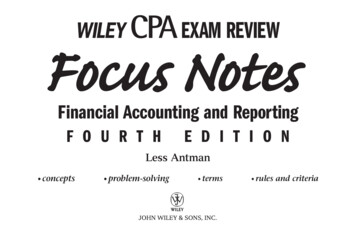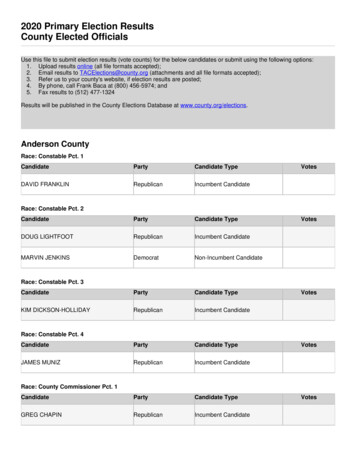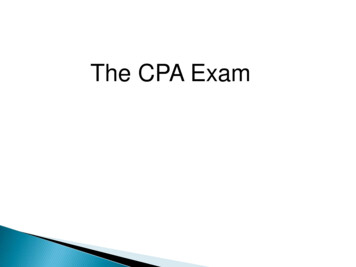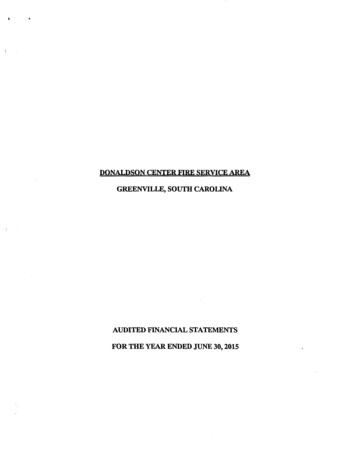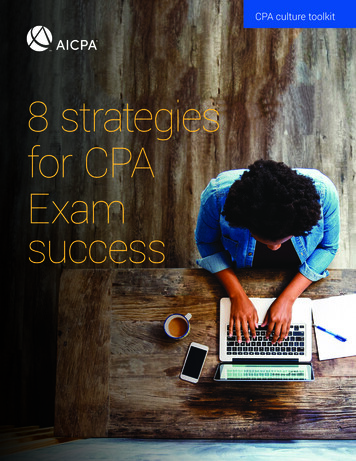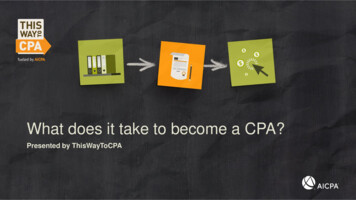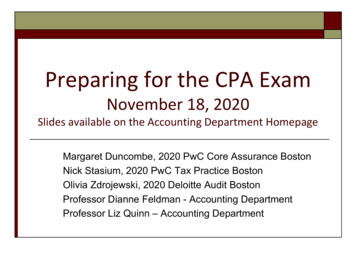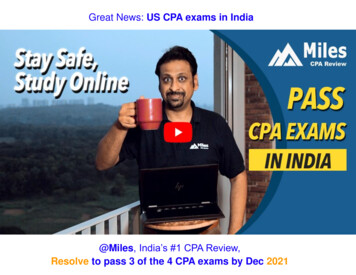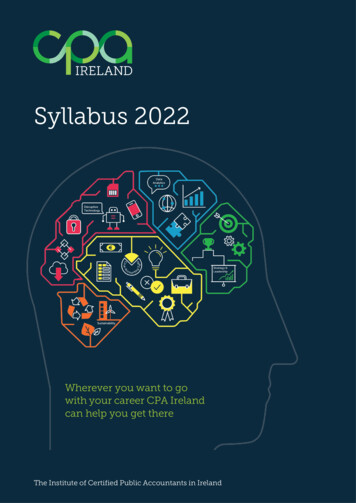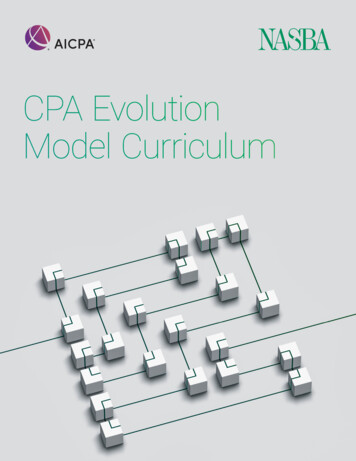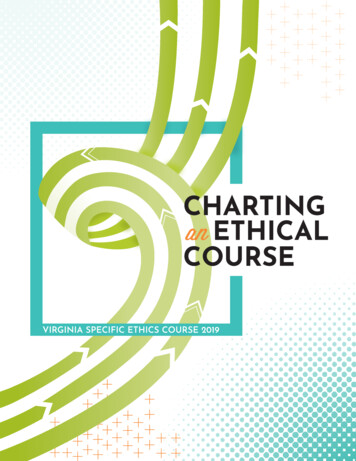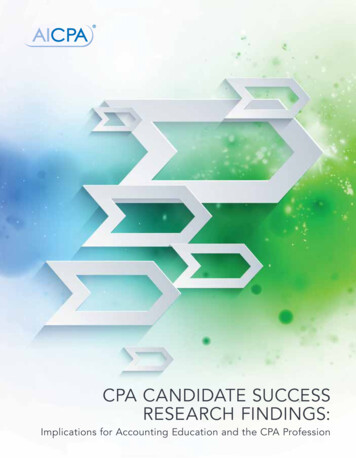
Transcription
CPA CANDIDATE SUCCESSRESEARCH FINDINGS:Implications for Accounting Education and the CPA Profession
The AICPA is committed to efforts that advance the CPA profession and help ensurea robust pipeline of future CPAs. To do so, it commissions research in multiple areas,including students and academics.At the request of the AICPA, two academics, Greg Gaynor, Ph.D., CPA, from the University ofBaltimore, and Sidney Askew, MBA, CPA, from the Borough of Manhattan Community College,conducted research on accounting programs, primarily those programs with large numbersof students sitting for, and ultimately passing, the CPA Exam. The intent of this research,known officially as CPA Candidate Success Research, was to gain insights and identify thebest practices employed by institutions with high sit and pass rates. That information could beshared with, and/or leveraged by, other accounting programs to ultimately increase the overallnumber of accounting students sitting for, and passing, the CPA Exam.CPA CANDIDATE SUCCESSRESEARCH FINDINGS:Implications for Accounting Education and the CPA ProfessionTheir findings have implications for a multitude of stakeholders responsible for educating,mentoring and guiding individuals toward becoming CPAs — including the AICPA, whichhas a key objective to ensure a robust pipeline of future CPAs.Clearly, CPA Candidate Success Research does not reside in a vacuum. There are numerousfactors outside the scope of this research that affect the CPA profession’s ability to attractand retain talent. Rather, this research provides insights into a series of undertakings andrelationships that, when linked with other efforts and initiatives, can lead to increasedsit and pass rates.Steve MatzkeDirector, Faculty & University InitiativesAmerican Institute of CPAsCPA Candidate Success Research Findings 1
RECOMMENDATIONS FORCOLLEGES, UNIVERSITIES AND EMPLOYERSThe following recommendations are basedon the findings from the CPA CandidateSuccess research, as well as previousresearch that has offered important insightsas to how various stakeholders contributeto students becoming CPAs.Colleges and Universities Monitor students’ sit and pass rates onthe CPA Exam. The National Associationof State Boards of Accountancy (NASBA)can provide institutions with customizedreporting on CPA Exam sit and pass rates. Structure accounting programs,especially at the graduate level, so thatstudents attain the necessary credits totake the CPA Exam and meet licensurerequirements. Encourage students to take the examas soon as possible after graduation.Students are more likely to complete allsections of the CPA Exam if they beginthe process while enrolled or immediatelyfollowing graduation. Promote/acknowledge students who passthe CPA Exam. This can motivate otherstudents who will be taking the CPA Exam. E mploy faculty who are CPAs. Researchshows that having CPAs in the classroominfluences students to become CPAs. H ave a knowledgeable faculty or staffmember advising students as to staterequirements for the CPA Exam andlicensure. Less ambiguity can affect astudent’s decision to become a CPA. Invite CPAs to speak to students. Exposureto CPAs and a grounded understanding ofthe role they play in society can motivatestudents to become CPAs. P romote free AICPA Student Membership.All accounting majors are eligible for freeAICPA membership. Students can enroll atThisWayToCPA.com. Students can accessresources about the profession and learnof the variety of careers available to CPAsand how to navigate toward CPA licensure. P rovide students access to accountingclubs. Research validates that accountingassociations, such as Beta Alpha Psi,help create a CPA culture that influencesstudents to become CPAs.Employers H ave a strong presence on universitycampuses. Opportunities to engagewith students help to increase students’interest in becoming a CPA. E ncourage new hires to take the CPAExam. Taking the CPA Exam closerto graduation directly correlates withindividuals completing the exam andseeking licensure. P rovide competitive compensation. Ensurethat starting salaries are on par withstarting salaries of other business majors. S tress the value of the CPA throughoutone’s professional career. Pay for CPA Exam review courses.Research shows that candidates aremore likely to pass the CPA Exam if theiremployers offer financial incentives to takethe exam. Provide bonuses for employees who passthe CPA Exam within a specified time. Encourage university programs topromote the CPA profession. Fosteringa CPA culture on campus positivelyinfluences students’ decision to becomea CPA. Support employees who are studying forthe exam with time off or flexibility. P rovide students with positive internshipexperiences. The opportunity for qualityinternships is a motivating factor forstudents to become a CPA. Tailor curriculum toward CPA Examcontent and competencies to theextent possible.CPA Candidate Success Research Findings 3
THE AICPA’S PERSPECTIVE:AFFECTING THE GROWTH IN THE NUMBER OF CPAsTaken as a whole, the research helps toinform AICPA initiatives that are designedto fill the pipeline of future CPAs.Accounting in High School The AICPA is working with keystakeholders, including state CPAsocieties, to develop and launch an honorshigh school accounting course that may beaccepted as college credit. Efforts includegrowing the existing Accounting Pilotand Bridge Program in the states whereit currently exists and launching thisprogram in new states. The AICPA launched and supportsStartHereGoPlaces.com — a brandand website for high school accountingteachers and students. The site includesactivities, such as the popular online,interactive game Bank On It , whichreinforces accounting principles andengages students in the study ofaccounting. The AICPA partners with nationalorganizations to promote the accountingprofession to high school administrators,teachers and students.Accreditation The AICPA has an interest in accreditationand its role in ensuring the quality ofaccounting education given its impacton the pipeline of CPAs who serve thepublic interest. One of the AICPA’s roles is to assist inbridging the gap between the profession(the end users of accreditation) andaccreditors and universities to ensurestudents have the competencies requiredto serve the public interest. To that end, the AICPA is working onaccounting accreditation with AACSB, aswell as other accreditors, and through itspartnership with NASBA.Accounting Ph.D. Initiatives The AICPA supports and providesresources for CPAs in the classroom. The AICPA provides funding to minoritydoctoral students through the MinorityDoctoral Students Program. The AICPA Foundation is developing anew iteration of the Accounting DoctoralScholars (ADS) Program. This programrecruits CPAs to enroll in Ph.D. programsand to ultimately join the faculty atcolleges and universities throughout theUnited States. The original ADS Program,funded by 121 firms, state CPA societies,the AICPA and others, has supported 108newly minted and future Ph.D.s.Campus CPA Champion ProgramDiversity The AICPA is launching a new AcademicChampion Program in fall 2016 to increasethe focus on creating a “CPA culture” onuniversity campuses. The program willidentify faculty at select universities topartner with the AICPA to help promotethe CPA profession. The AICPA’s National Commissionon Diversity and Inclusion and keystakeholders have created thediversity pipeline initiative to increaserepresentation of underrepresentedminorities in the accounting profession. The AICPA is working with the NationalCommission on Diversity and Inclusion totailor the Academic Champion Program atcolleges and universities with large, diversestudent populations to increase the numberof underrepresented minorities in theCPA profession. The AICPA is developing a volunteertoolkit, to be leveraged by AcademicChampions, which will provide resourcesto faculty, students and professionalsto ensure a closer connection with theprofession in the classroom. AICPA offers undergraduate and graduateminority scholarships and fellowships forminority accounting students. AICPA provides opportunities, such asthe Accounting Scholars LeadershipWorkshop, to strengthen students’professional skills and understanding ofthe limitless possibilities and benefits ofearning the CPA credential.CPA Examination A new version of the Uniform CPA Examwill be available April 1, 2017. Higher-order cognitive skills will be tested. The CPA Exam will increase from 14 to 16hours in length. Testing windows will be extended by10 days to allow candidates more flexibilityto take the CPA Exam.CPA Candidate Success Research Findings 5
EXECUTIVE SUMMARY:REPORT ON THE CPA CANDIDATESUCCESS RESEARCH PROJECTon the exam. However, we also solicitedinput from schools enjoying less successto better identify challenges that suchaccounting departments may be facing inimplementing useful initiatives related to theCPA Exam.Greg Gaynor, Ph.D., CPA Sidney Askew, MBA, CPAU.S. higher education has been underincreased scrutiny in recent years, oftenbeing asked to do more with less due toreduced funding and resources. A robustdiscussion of the topic lies outside thescope of this paper. However, we notethat many accounting programs may nowbe equipped with fewer full-time facultymembers and resources at precisely thetime that the profession is hoping toincrease CPA Exam sit and pass rates.Motivation for Research StudyThe CPA Exam remains a rigorous rite ofpassage for those entering the accountingprofession. As the protection of thepublic remains the duty of the accountingprofession, it is in the public’s best interestto have a strong pipeline of CPA candidatesdemonstrating their proficiency by passingthe CPA Exam. Concerns have been raisedregarding demographic challenges facingthe field of accounting. According to theAICPA, over 40% of today’s CPAs will beretiring by 2020. In addition, the AICPAwould like to close the gap between thosegraduating with accounting degrees andthose sitting for the exam.With these factors in mind, we conductedthe CPA Candidate Success ResearchProject with the ultimate goal of findingways to help increase CPA Examsit and pass rates. Our study focusedprimarily on identifying the characteristicsand techniques, or “best practices,” thatcollege and university accounting programsemploy to help their students achievesuccess on the exam. Identification ofthese best practices can help the entirepopulation of colleges and schools improveperformance on the exam.Identification of these bestpractices can help the entirepopulation of colleges andschools improve performanceon the exam.Approach of StudyFor our study, we sought a collaborativeeffort among colleges and universities togenerate useful ideas for the profession atlarge. There are dramatic differences amongbusiness schools in their missions, levelsof resources and student characteristics.In light of these significant differences, itcan be expected that students from someschools will have more success on the CPAExam than will others. We considered itworthwhile to start our inquiry with thoseschools with relatively high sit and pass ratesProspective Audience for This StudyNaturally, we hope to continue discussingour study and the contents of this reportwith fellow accounting educators as part ofa sustained initiative to improve sit and passrates on the exam. However, we suggestthat accounting educators cannot go italone. We believe the audience for our studyalso includes those outside the accountingprofession, such as school administrators,accreditors and state legislators, who helpdetermine the allocation of educationalresources and funding and who may notbe familiar with the issues the accountingprofession faces. Alternatively, accountingindustry stakeholders, such as firms, statesocieties and organizations, and licensingboards may be well aware of the issues theprofession faces but may be less familiarwith the challenges accounting educatorsface in the current era of scrutiny andreduced resources for higher education. Wehope our report can add to the collectivedialogue among the various stakeholdersin a broad effort toward the shared goal ofprotection of the public through improvedCPA Exam sit and pass rates.Survey MethodologyWe used a survey approach to solicit bestpractices feedback from schools in theform of open-ended survey questionsand, often, follow-up conversations on avariety of topics. In compiling our initialsample of schools to contact, we tried, tothe extent possible, to avoid focusing onthe exact numbers and rankings reportedin NASBA’s CPA Exam Performance booksbecause of the inherent ambiguities of thedata themselves. For example, the specificstructure of a school’s accounting program,as well as the procedures of the state inwhich it operates, can affect whether a givenstudent is associated with a certain school inthe performance data. Another reason notto belabor exact pass rates is that our studyis meant to benefit accounting programs asa whole, as opposed to celebrating someprograms at the expense of others.CPA Candidate Success Research Findings 7
Initial Survey QuestionsWe asked the following questions as part ofan initial survey:“For the following questions please feelfree to distinguish between your graduateand undergraduate accounting programs asappropriate:1. W e are interested in hearing aboutany initiatives you have implementedthat have been especially beneficialfor students in preparation for the CPAExam. Please discuss any unique orinnovative ideas you have implementedin the following areas: Accounting curriculum Course content delivery method (onlineclasses, hybrid classes, etc.) CPA review classes and/orpartnerships/relationships with CPAExam test preparation companies(Becker, Wiley, etc.) Any other initiatives that havecontributed to student success onthe CPA Exam2. O verall, what would you considerto be the three main factors behindyour accounting program’s success indeveloping graduates who sit for, andultimately pass, the CPA Exam?3. What ideas or initiatives are youexploring for future implementation toimprove CPA Exam pass and sit rates?4. What do you consider the three mainobstacles/challenges you and/or otherschools face in improving CPA Exam passand sit rates? (Responses to this questionwill be kept anonymous.)5. W hat do you believe are the mainimpediments/deterrents that keepaccounting graduates from eventuallysitting for the CPA Exam? (Responses tothis question will be kept anonymous.)6. Suppose your administration were togive your department a recurring annualpayment of 25,000 for the expresspurpose of improving CPA Examsit and pass rates. How do you think themoney would be best spent? (Responsesto this question will be kept anonymous.)7. What advice would you give the AICPAand other industry stakeholders withregard to their efforts to increase thenumber of students attempting, andultimately passing, the CPA Exam?(Responses to this question will be keptanonymous.)8. A ny other thoughts you would like toshare? (Responses to this question willbe kept anonymous.)Discussion of Key ThemesIn summary, schools often cite the followingfactors as the primary keys to their success: The ability to recruit and retain greatstudents The fact that these students secured jobswith firms that pay for a review class andencouraged them to take the exam Knowledgeable advisement of studentsas to state requirements for exam/licensureIt is important to note theoften dramatic differences thatexist among schools in attributessuch as mission, budget andstudent characteristics. An accounting program structured,especially at the graduate level, tofacilitate students attaining the necessarycredits for the exam and possibly evenbeginning to take the exam while stillenrolled The positive signal and confidenceboost that current students receive whenwitnessing the students who went beforethem having success on the exam Some schools have also tailored theircurriculum, at least to some degree,toward CPA Exam content. In selectinstances, schools also host and/orteach CPA review classes, in some casesawarding academic credit for the classes.Schools suggest the following to beamong the major challenges in improvingsit and pass rates: Accounting programs lose top studentsto other majors, such as finance. The various state rules make it tough forstudents who are not sure of the state inwhich they will reside after graduation. Public accounting firms are not providingthe salaries/working conditions necessaryto attract/retain the top students. We suggest that many students do notbelieve that it will have been worth itto take the CPA Exam if they do noteventually work in public accounting for asignificant length of time. It is reasonableto suggest that, for some students, theprospect of having to take the examhelps to deter them from entering publicaccounting.Important Differences AmongInstitutions of Higher LearningIt is important to note the often dramaticdifferences that exist among schools inattributes such as mission, budget andstudent characteristics. In light of suchdifferences, we believe it is reasonable toexpect that differences in pass rates amongschools will persist even if efforts aresuccessful in improving sit and pass ratesfor the entire population. As the responsesin our study suggest, schools take a varietyof approaches to preparing students forthe CPA Exam. Ironically, some schoolswith high pass rates expend little effort inpreparing their students specifically for the Some students wait too long to take theexam and lose motivation.CPA Candidate Success Research Findings 9
exam. Normally in such cases, the school’sstrong reputation attracts top students andcorporate recruiters. These students securejobs at large accounting firms who then payfor review courses, thereby helping enablestudent success on the exam. Such schoolsmay view the CPA Exam as too short-termand, instead, emphasize preparing studentsfor what they might describe as a longterm successful accounting career. Thisapproach works for these schools becausethe prestige of the school helps studentssecure jobs even if they have not receivedexplicit preparation for the CPA Exam.The increase in researchoutput necessary to earntenure gives tenure-track facultyless opportunity to focus on theCPA Exam.Other schools in our sample devoted moreresources to preparing their studentsspecifically for the CPA Exam. In selectinstances, schools offer for-academic creditCPA review courses in their curriculumand/or require students to take the CPAExam while still enrolled. While theseinitiatives may work for some schools,we note that they may not be feasibleat others, especially those with smallerbudgets and enrollments. Some schoolsmay be unable to handle the relativelylarge costs of administering these rigorouscourses and/or may be unable to sustainthe enrollment attrition that can resultfrom imposing additional requirements onstudent performance.We believe that an awareness of someof the trends facing accounting highereducation will aid the effort to improve sitand pass rates for the CPA Exam. Thesetrends have and will continue to affectschools to a varying degree. However, wesuggest that the schools whose sit and passrates are most in need of improvement maybe most affected by these trends.Challenging Trends in Higher Education D eclining enrollments may prompt adecrease in academic standard T he increase in non-tenure track facultypositions with relatively little job securitymay be associated with grade inflationand less rigorous courses T he increase in research outputnecessary to earn tenure givestenure-track faculty less opportunityto focus on the CPA Exam T he rise of micro-credentialingSuggestions and Recommendationsfor Increasing Sit/Pass RatesBased on the feedback we have receivedfrom a variety of schools, combinedwith our own experiences as accountingeducators, we offer the followingsuggestions and recommendations forvarious accounting stakeholders in a helpfuland collaborative spirit. Designate a faculty member to be themain point of contact (or “AcademicChampion”) for CPA exam/licensureissues and questions. Seek increased participation fromaccounting firms (e.g., serving on anAdvisory Board, participating in careerfairs, presenting to students). Engage with student organizations,such as Beta Alpha Psi, the NationalAssociation of Black Accountants(NABA) and the Association of LatinoProfessionals for America (ALPFA). Offer CPA review classes on campus. Consider creating a practice testingcomputer lab and/or study room oncampus.While outside of the purview of theacademy, the following are based onrepeated themes and feedback: Consider standardizing the exam andlicensure requirements across statesto enhance efficiency and students’perception of the industry. Consider increased higher-order skills/critical-thinking testing on the CPA Examto improve its image and perceived value.Consider adding a more “generalized”first part to the exam that may appeal tothose currently choosing other credentialsand may help to counter the effects of therise in micro-credentialing. Consider adjusting the testing windowsand application procedures to betterenable students to begin the examinationprocess while still enrolled.DiscussionIn this report, we discuss the main factorsthat high-pass-rate schools have citedas the key elements to their students’success on the exam. Ideally, their successcould easily be replicated at otherschools through the mere adoption ofthese procedures. However, as we havesuggested, the dramatic differences amongbusiness schools in their missions, level ofresources and student characteristics makethis an unrealistic proposition. In much theCPA Candidate Success Research Findings 11
same way that college athletics often usedivisions to group together schools withsimilar profiles, we suggest that it is to beexpected that there will be differences in sitand pass rates among schools, even if andwhen the efforts to improve overallsit and pass rates prove successful.Though we acknowledge thecomplexity of the issue, we areoptimistic that improvementin CPA Exam sit and passrates is possible.Because of the differences amongschools, we suggest that proceduresthat work for one school may not workfor others. We note that the suggestionsand recommendations described inthis report may have already beenimplemented at some schools whosepass rates are still not as high as desired.Or, the accounting faculty at a givenschool may face significant barriers toimplementation due to the constraints theyface in an increasingly scrutinized highereducation system. As discussed, therecan often be significant disincentives forfaculty, especially tenure-track, to focustheir efforts and attention on the CPAExamination and licensure process. Theymay receive little to no credit from theirschool for their considerable efforts inhelping students prepare for the exam. Or,worse, they may actually receive blame forthe issue of relatively low pass rates if theycall attention to the problem in an effort toremedy it.Though we acknowledge the complexityof the issue, we are optimistic thatimprovement in CPA Exam sit and passrates is possible. As indicated in ourrecommendations, we suggest it is bestachieved through the concerted efforts ofvarious accounting stakeholders. Throughthis, we can tap the natural energy andenthusiasm of what we believe to be alarge number of accounting educators whowould prefer to focus more of their effortson the CPA Examination process, but whoare naturally reluctant to do so out of careerconcerns. Though we may not foreseesignificant changes in the higher educationreward system in the near future, webelieve programs such as AICPA’s proposalfor campus “academic champions” holdpromise in their ability to empoweraccounting faculty to devote more effortstoward the CPA Exam.AICPA Academic Team Contact Information:Yvonne L. Hinson, CPA, CGMA, Ph.D.Director — Academic-in-Residence 1.919.490.4396yhinson@aicpa.orgSteve Matzke, MBADirector — Faculty & University Initiatives 1.919.402.4682smatzke@aicpa.orgTo inquire about CPA Exam reporting, please contact:AICPA, ExaminationsPrinceton South Corporate Center100 Princeton South, Suite 200Ewing, NJ 08628609.671.2902National Association of State Boards of Accountancy150 Fourth Ave. North, Suite 700Nashville, TN 37219–2417Phone: 615.880.4200 2016 American Institute of CPAs. All rights reserved.DISCLAIMER: The contents of this publication do not necessarily reflect the position or opinion of the AmericanInstitute of CPAs, its divisions and its committees. This publication is designed to provide accurate andauthoritative information on the subject covered. It is distributed with the understanding that the authors are notengaged in rendering legal, accounting or other professional services. If legal advice or other expert assistance isrequired, the services of a competent professional should be sought.For more information about the procedure for requesting permission to make copies of any part of this work, pleaseemail copyright@aicpa.org with your request. Otherwise, requests should be written and mailed to the PermissionsDepartment, AICPA, 220 Leigh Farm Road, Durham, NC 27707-8110.CPA Candidate Success Research Findings 13
19635-824888.777.7077 aicpa.org
United States. The original ADS Program, funded by 121 firms, state CPA societies, the AICPA and others, has supported 108 newly minted and future Ph.D.s. Campus CPA Champion Program The AICPA is launching a new Academic Champion Program in fall 2016 to increase the focus on creating a "CPA culture" on university campuses. The program will
